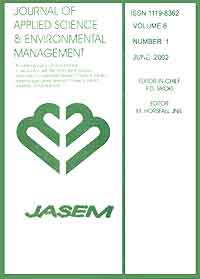
|
Journal of Applied Sciences and Environmental Management
World Bank assisted National Agricultural Research Project (NARP) - University of Port Harcourt
ISSN: 1119-8362
Vol. 22, No. 5, 2018, pp. 719-724
|
 Bioline Code: ja18123
Bioline Code: ja18123
Full paper language: English
Document type: Research Article
Document available free of charge
|
|
|
Journal of Applied Sciences and Environmental Management, Vol. 22, No. 5, 2018, pp. 719-724
| en |
Health risk assessment model for lead contaminated soil in Bagega Community, Nigeria
ALABA, OC; OPAFUNSO, ZO & AGYEI, G
Abstract
The study developed health risk assessment model for lead contaminated soil in Bagega community
using United States Environmental Protection Agency (US EPA) and Canadian Standards Association (CAS) standard
procedures. Questionnaires were used to investigate the background causes and exposure pathways of lead contaminated
soil. Soil samples were collected at five different sites and cancer health risk values were estimated using equations
proposed by US EPA. The results show that 84.0 % of the respondents agreed that the causes of lead poisoning in the
study area were due to the activities of artisanal gold miners. The major exposure pathways to lead contaminated soil are
ingestion, dermal contact and inhalation while the soil ingestion generates high cancer risk, dermal contact generates low
cancer risk and that of inhalation was insignificant when compared with 1.00E-06 (mg/kg/day) WHO cancer risk standard.
The mean cancer health risk value for combined exposure pathway is ranged from 1.49E-03 mg/kg/day to 5.99E-03
mg/kg/day. The study established that lead contaminated soil posed cancer health risk to the people of the study area.
Keywords
Health risk model; exposure pathways; lead contaminated soil; soil ingestion
|
| |
© Copyright 2018 - Alaba et al.
|
|
